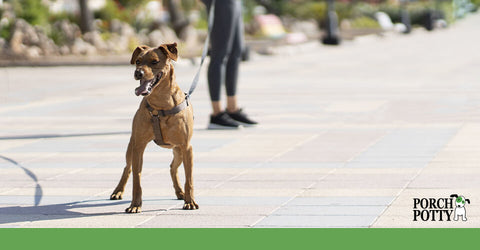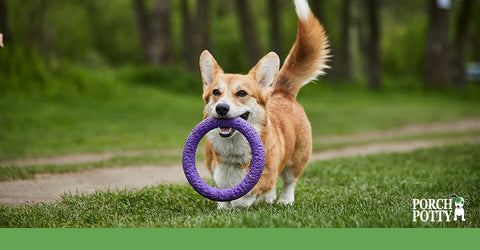
A tan dog enjoys a walk with its owner on a hot summer's day.
As Aussie dog owners, we're no strangers to the diverse climates our beautiful country throws our way. From the scorching heat waves of summer to the chilly winds of winter, not to mention the unpredictable bouts of rain and bushfire seasons, our weather can pose a unique set of challenges. It's crucial, then, for the safety and comfort of our furry mates, to adapt our approaches to toilet training during these extreme seasons or when facing environmental risks. This isn't just about convenience; it's about ensuring the well-being of our beloved dogs while maintaining the cleanliness of our homes.
Adapting toilet training strategies for different seasons means being flexible and understanding. It requires a blend of indoor and outdoor training methods, tailored to keep our dogs safe from the elements while still learning effectively. This article aims to guide you, the dedicated dog owner, through practical, actionable advice for navigating toilet training through Australia's most challenging weather conditions. Whether you're a seasoned pet parent or a first-time dog owner, our goal is to support you in fostering a healthy, happy environment for your dog, no matter what the weather outside looks like.
Identifying Dangerous Seasons
Australia's vast and varied landscape brings with it a wide range of weather conditions and environmental hazards, each presenting unique challenges for dog owners. Understanding these dangers is the first step in safeguarding our pets during their toilet training journey. Here are some key concerns to be mindful of:
Heatwaves and High Temperatures
- The risk of heatstroke and dehydration for dogs left outside too long.
- Hot pavements can burn a dog's paws, making outdoor toilet breaks painful.
- Increased presence of snakes seeking warmth, posing a risk to curious pets.
Heavy Rain and the Wet Seasons
- Potential for flooding, making some outdoor areas unsafe for dogs.
- Increased likelihood of encountering toxic toads, especially in the northern regions.
- Wet weather can discourage dogs (and owners) from regular outdoor toilet routines.
Cold Snaps
- Risk of hypothermia for short-haired or small breeds during outdoor trips.
- Icy conditions can lead to slips and injuries for both dogs and owners.
Bushfire Seasons
- Smoke and ash can irritate a dog's respiratory system, eyes, and skin.
- The need to stay indoors for safety can disrupt regular toilet habits.
Environmental Hazards
- Exposure to toxic plants, which can vary by region and be more accessible during certain seasons.
- Increased activity of insects such as ticks and fleas, which can cause diseases.
Understanding these seasonal and environmental challenges is crucial for planning a toilet training strategy that keeps your dog safe, comfortable, and healthy throughout the year.

A black, tan and white Corgi stands on a Porch Potty set up indoors.
Indoor Training Advantages
In the face of Australia's extreme weather conditions and environmental hazards, indoor toilet training presents a safe and effective alternative for your dog. Let's explore the safety benefits and the role of innovative solutions like the Porch Potty in ensuring your dog's well-being and your peace of mind.
Safety Benefits During Extreme Weather Conditions:
- Protection from the Elements: Indoor training shields your dog from the harsh conditions of heatwaves, cold snaps, and torrential rain, preventing heatstroke, hypothermia, and discomfort.
- Avoidance of Environmental Hazards: Keeps your dog away from dangers such as toxic plants, insects, and snakes that are more prevalent during certain seasons.
- Reduces Stress: Indoor environments can offer a calm and controlled setting for toilet training, particularly during the noisy and unsettling periods of bushfires and thunderstorms, which can frighten dogs and disrupt their routines.
Indoor Solutions like Porch Potty
- Hygiene and Convenience: The Porch Potty provides a clean, designated area for your dog to relieve itself without the mess or hassle of outdoor training during inclement weather. It's designed to drain and clean easily, making it a hygienic option for indoor use.
- Consistency in Training: By offering a consistent spot for your dog to go, regardless of the weather outside, you reinforce good toilet habits that can seamlessly transition between indoor and outdoor settings.
- Flexibility: Perfect for apartment dwellers or homes without easy access to a secure outdoor area, the Porch Potty ensures your dog can always have a safe space to go, no matter the time of day or night.
Incorporating an indoor toilet training solution like the Porch Potty into your pet care routine offers a blend of safety, convenience, and hygiene. It ensures that, despite the unpredictable and sometimes extreme Australian climate, your dog's toilet training can continue uninterrupted, keeping them safe and comfortable throughout the year.
Outdoor Training Advantages
While indoor training has its merits, especially during extreme weather conditions, outdoor toilet training offers invaluable benefits for a dog's physical and mental health during milder conditions. Embracing the great outdoors, even if just in the backyard, can significantly enhance your dog's overall well-being and happiness. Here’s why outdoor training is beneficial, along with safety tips for navigating transitional weather periods.
Benefits of Outdoor Training:
- Exercise and Stimulation: Outdoor toilet breaks naturally incorporate physical activity and mental stimulation as dogs explore their environment, sniff, and mark territory, which is crucial for their health and happiness.
- Socialisation: Exposure to the outside world, even in controlled environments, helps dogs become more comfortable with various sights, sounds, and experiences, leading to better social behaviour.
- Routine and Environment: Dogs thrive on routine, and regular outdoor breaks provide a consistent schedule that aligns with their natural instincts, promoting healthier toilet habits.
Safety Tips for Outdoor Training During Transitional Weather
- Weather Awareness: Always check the weather before heading out and avoid the hottest and coldest parts of the day. Transition periods between seasons can be unpredictable, so staying informed helps you make the best decision for your dog’s outdoor time.
- Protective Gear: In cooler weather, consider a coat for short-haired breeds, and in hot weather, ensure your dog has access to shade and fresh water. Dog booties can protect paws from hot pavements and icy conditions.
- Pest Protection: Ensure your dog is up-to-date with flea, tick, and heartworm prevention, especially during warmer months or in areas prone to these pests. Transitional weather can see a surge in pest activity.
- Supervised and Secure: Always supervise your dog’s outdoor toilet breaks, ensuring they’re safe from potential hazards like toxic plants or unsupervised interactions with wildlife.
- Gradual Acclimatisation: Help your dog adjust to outdoor conditions by gradually increasing their exposure. This is particularly important as seasons change, allowing them to become comfortable with new temperatures and conditions.
Outdoor toilet training, when practised during suitable weather conditions, not only supports your dog's physical and mental health but also strengthens your bond through shared experiences. By following these safety tips, you can ensure that outdoor training remains a positive, healthy aspect of your dog’s routine, regardless of the changing seasons.

A tan Corgi carries a purple chew ring as it plays outside in the grass.
Balancing Training Approaches
Successfully navigating toilet training for your dog involves a flexible approach that balances indoor and outdoor training. This flexibility ensures your dog remains comfortable and safe, regardless of the weather or environmental conditions. Here are strategies for seamlessly transitioning between training environments and understanding your dog’s preferences and discomforts.
Seamless Transition Between Indoor and Outdoor Training
- Consistent Commands and Cues: Use the same verbal cues and commands for toilet behaviour, whether indoors or outdoors. This consistency helps your dog understand what is expected, regardless of the location.
- Gradual Introduction: Gradually introduce your dog to the concept of using both indoor and outdoor spaces for toilet needs. Start with one method (usually indoor for puppies) and slowly incorporate outdoor training as they become more comfortable and the weather permits.
- Simulate Outdoor Elements Indoors: For dogs that prefer the outdoors, try simulating elements of the outside within the indoor training area. This could include using natural grass patches like those found in products such as the Porch Potty.
Understanding and Responding to Your Dog’s Preferences and Discomforts
- Observe Body Language: Dogs communicate discomfort, preference, and readiness through body language. Watch for signs of unease with certain environments or weather conditions and adjust accordingly.
- Provide Choices: Where possible, offer your dog the choice between indoor and outdoor options, especially during transitional weather periods. This helps you understand their preferences and encourages autonomy in their toilet habits.
- Address Discomforts: If your dog shows signs of discomfort with either option, investigate the cause. It could be environmental (e.g., too hot, too cold), related to the training area (e.g., too exposed, not private enough), or health-related. Address these issues to make toilet training a positive experience.
- Patience and Positive Reinforcement: Transitioning between indoor and outdoor training can be confusing for some dogs. Maintain patience and use positive reinforcement to encourage desired behaviours. Treats, praise, and affection go a long way in making them comfortable with both settings.
Balancing indoor and outdoor toilet training approaches requires an understanding of your dog’s needs and preferences. By employing consistent training methods, offering choices, and being responsive to your dog’s comfort levels, you can create a flexible and effective toilet training routine that suits any weather condition or environmental challenge. This balanced approach ensures the well-being of your dog while maintaining cleanliness and convenience for your lifestyle.
The journey of toilet training your dog, especially amidst the unpredictable and often extreme Australian climate, underscores the need for adaptable and attentive approaches. By tailoring our training methods to suit the changing seasons and environmental conditions, we not only ensure the safety and comfort of our beloved pets but also reinforce positive habits that last a lifetime. An understanding, flexible strategy—balancing indoor convenience with the natural benefits of outdoor training—allows us to navigate these challenges seamlessly, always putting the well-being of our dogs at the forefront.
As responsible dog owners, our commitment to adapting our approaches, responding to our dogs' preferences and discomforts, and maintaining a consistent routine across all seasons is paramount. It's this dedication to their health, happiness, and safety that deepens the bond between us and our furry friends, making every effort in their training journey well worth it. Remember, the goal is not just to train our dogs for today but to equip them with the skills and comfort they need to thrive in any weather, ensuring a happy, healthy life alongside their human companions.
For more information on toilet training your dog, check out these articles:
Will an Indoor Dog Toilet Deter Outdoor Play?



